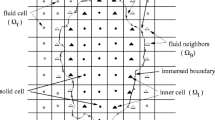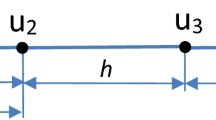Abstract
A nonet-Cartesian grid method, based on anisotropic/isotropic refinement, is presented for solving the Euler equations in gas dynamic problems. Grids are generated automatically, by the recursive subdivision of a single cell into nine subcells for isotropic nonet-Cartesian grids and into three subcells independently in each direction for anisotropic nonet-Cartesian grids, encompassing the entire flow domain. The grid generation method is applied here to steady inviscid shock flow computation. A finite difference formulation for the Euler equation using nonet-Cartesian grids is used to treat complex two-dimensional configuration. Results using this approach are shown to be competitive with other methods. Further, it is demonstrated that this method provides a simple and accurate procedure for solving flow problems involving multielement airfoils.
Similar content being viewed by others
REFERENCES
Berger, M. J., and LeVeque, R. (1989). An Adaptive Cartesian Mesh Algorithm for the Euler Equations in Arbitrary Geometries, AIAA Paper-89-1930.
Bayyuk, S. A., Powell, K. G., and van Leer, B. (1993). An Algorithm for the Simulation of 2-D Unsteady Inviscid Flows around Moving and Deforming Bodies of Aribitrary Geometry, AIAA Paper-93-3391.
Clarke, D. K., Salas, M. D., and Hassan, H. A. (1986). Euler calculations for multi-element airfoils using Cartesian grids. AIAA J. 24, 353–358.
Coirier, W. J., and Powell, K. G. (1995). An accuracy assessment of Cartesian-mesh approaches for the Euler equations. J. Comput. Phys. 117, 121–131.
Coirier, W. J., and Powell, K. G. (1996). Solution adaptive Cartesian cell approach for viscous and inviscid flows. AIAA J. 34, 938–945.
De Zeeuw, D., and Powell, K. G. (1993). An adaptively refined Cartesian mesh solver for the Euler equations. J. Comput. Phys. 104, 56–68.
Gropp, W. D. (1987). Local uniform mesh refinement with moving grids. SIAM J. Sci. Stat. Comput. 8, 292–304.
LeVeque, R. J. (1988). Cartesian grid methods for flow in irregular regions. In Morton, K. W., and Baines, M. J. (eds.), Num. Meth. Fl. Dyn. III, Clarendon Press, pp. 375–382.
Mitcheltree, R. A., Salas, M. D., and Hassan, H. A. (1988). Grid embedding technique using Cartesian grids for Euler solutions. AIAA J. 26, 754–756.
Nakano, A., Satofuka, N., and Shimomura, N. (1996). A Cartesian grid approach to compressible viscous flow computations. In Computational Fluid Dynamics, John Wiley & Sons Ltd.
Morinishi, K. (1992). A finite difference solution of the Euler equations on non-body-fitted Cartesian grids. Computers Fluids 21, 331–344.
Powell, K. G. (1998). Solution of the Euler Equations on Solution-Adaptive Cartesian Grids, CFD Review, World Scientific, pp. 65–92.
Quirk, J. (1994). An alternative to unstructured grids for computing gas dynamic flows around arbitrarily complex two-dimensional bodies. Computers Fluids 23, 125–142.
Toro, E. F. (1999). Riemann Solvers and Numerical Methods for Fluid Dynamics: A Practical Introduction, Springer.
Wu, Z. N. (1996). A genuinely second-order accurate method for viscous flow computations around complex geometries. In 15th Conf. Numer. Meth. Fl. Dyn., Monterey, USA, June 24–28.
Wu, Z. N. (1998). Anisotropic Cartesian Grid Approach for Viscous Flow Computations, CFD Review 1998, World Scientific, pp. 93–113.
Deister, F., and Hirschel, E. H. (1999). Adaptive Cartesian/Prism Grid Generation and Solutions for Arbitrary Geometry, AIAA 99-0782.
Deister, F., Rocher, D., Hirschel, E. H., and Monnoyer, F. (1999). Three Dimensional Adaptive Refined Cartesian Grid Generation and Euler Flow Solutions for Arbitrary Geometry, Proceeding for the 4th European CFD Conference, 1, Part 1, pp. 96–101.
Nomel, N. D., and Karman, S. L., Jr. (2000). Splitflow: Progress in 3D CFD with Cartesian Omni-Tree Grids for Complex Geometries Adaptive, AIAA 2000-1006.
Welterlen, T. J. (1999). Store Release Simulation on the F/A-18C Using Splitflow, AIAA 99-0124.
Quirk, J. J. (1992). An Alternative to Unstructured Grids for Computing Gas Dynamoic Flows around Arbitrarily Complex Two-Dimensinal Bodies, NASA Contractor Report 189612, ICASE Report No. 92-7.
Berger, M. J., and Colella, P. (1989). Local adaptive mesh refinement for shock hydrodynamics. J. Comput. Phys. 82, 64–84.
Azarenok, B. N. (2002). Variational barrier method of adaptive grid generation in hyperbolic problems of gas dynamics. SIAM J. Numer. Anal. 40, 651–682.
Liu, F., Ji, S., and Liao, G. (1998). An adaptive grid method and its application to steady Euler flow calculations. SIAM J. Sci. Comput. 20, 811–825.
Tang, H. Z., and Tang, T. Adaptive mesh methods for one-and two-dimensional hyperbolic conservation laws. SIAM J. Numer. Anal., to appear.
Author information
Authors and Affiliations
Rights and permissions
About this article
Cite this article
Li, K., Wu, ZN. Nonet-Cartesian Grid Method for Shock Flow Computations. Journal of Scientific Computing 20, 303–329 (2004). https://doi.org/10.1023/B:JOMP.0000025931.79444.99
Issue Date:
DOI: https://doi.org/10.1023/B:JOMP.0000025931.79444.99




